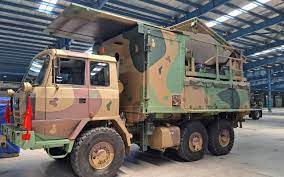A recent milestone achieved by the Indian Army involves the introduction of the “Swathi Mountains” radar, an evolution of the indigenous Weapon Locating Radar (WLR-M), designed to be more lightweight and compact. Created by the expertise of Bharat Electronics Limited (BEL) based in Bengaluru, this state-of-the-art radar system has the potential to redefine military operations, especially in demanding landscapes. Unraveling the features, capabilities, and implications of this technological marvel offers insights into its role in shaping the future of warfare.
At the core of modern military strategies, the Weapon Locating Radar (WLR) has emerged as an invaluable asset, employing intricate signal processing techniques to autonomously identify and trail hostile artillery, mortars, and rocket launchers. Beyond its primary role in hostile fire detection, the WLR proves equally adept at tracking friendly fire trajectories, thereby enabling precise calculations that enhance the accuracy of artillery strikes.
The radar’s supremacy rests in its capacity to meticulously monitor small projectiles across the battlefield, factoring in environmental variables to precisely estimate launch and impact coordinates. Notably, the WLR’s mobility and swift deployment attributes grant it adaptability to changing operational necessities, capable of scanning diverse zones without the need for physical repositioning.
The Swathi Mountains WLR distinguishes itself as an advanced electronically scanned phased array radar, meticulously tailored to excel in mountainous and high-altitude regions. A testament to indigenous technological prowess, this radar system is poised to make substantial contributions to India’s defense capabilities.
Engineered with the distinctive challenges of elevated terrains in mind, the Swathi Mountains WLR proves its mettle where conventional radar systems may falter. Its compact design and agility empower it to excel in environments characterized by varying topography, ensuring precision in detecting and tracking projectiles.
The Swathi Mountains radar system adeptly discerns mortar shells, rockets, and diverse projectiles, all the while distinguishing between projectile and non-projectile entities. Utilizing advanced signal processing algorithms, the radar effectively filters out undesired signals such as birds, clutter, and aircraft, maintaining accuracy even amidst complex scenarios.
A defining trait of the Swathi Mountains radar lies in its capability to predict trajectories and extrapolate launch and impact points. With the radar autonomously accommodating variations in height, accuracy in calculations is heightened, proving indispensable for effective artillery strikes and tactical decision-making.
Equipped with storage functionality, the radar system retains trajectory data, enhancing post-mission analysis and strategic planning. Moreover, its seamless integration with higher echelons guarantees synchronized efforts and real-time updates, fostering operational efficiency enhancements.
